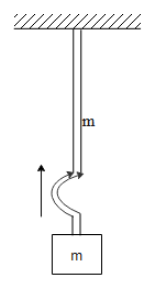Question
Question: A uniform rope of length l and mass m hangs vertically from a rigid support. A block of mass m is at...
A uniform rope of length l and mass m hangs vertically from a rigid support. A block of mass m is attached to the free end of the rope. A transverse pulse of wavelength λ is produced at the lower end of the rope. The wavelength of the pulse, when it reaches the top of the rope, is aλ. Find a2.

Solution
Make use of the formula given for the speed of a wave and find out by what factor the speed of the pulse changes when it propagates from the bottom to the top of the rope. Then use the fact that speed of a wave is directly proportional to its wavelength.
Formula used:
v=μT
Complete step by step answer:
The velocity of propagation a transfer wave or pulse in a stretched rope is given as v=μT, where T is the tension in the rope and μ is the linear mass density of the rope.In this case, it is given that the rope is uniform. Therefore, its linear mass density is constant at point on the rope. However, the rope has some mass, which means that the tension will be different at every point on the rope.
Since the tension is different, the velocity of the pulse will be different at different points.
Let the velocity of the pulse at the bottom of the rope be v and the tension in the rope at this point is T1=mg.
⇒v=μT1=μmg
Let the velocity of the pulse at the top of the rope be v’ and the tension in the rope at this point is T2=mg+mg=2mg (because it has to balance the mass and well the rope).
⇒v′=μT2=μ2mg
⇒v′=2(μmg)=2v.
This means that the speed of the pulse increases by a factor of 2 when it goes from the bottom to the top of the rope.The wavelength of a pulse is directly proportional to the speed of the pulse. Therefore, if the speed increases by a factor of 2 then its wavelength will also increase by a factor of 2.
It is given that the wavelength of the pulse at the bottom of the rope is λ.
Therefore, the wavelength of the pulse at the top will be 2λ.But it said that this wavelength is equal to aλ. Then this means that 2λ=aλ.
⇒a=2
∴a2=2
Hence, the value of a2 is 2.
Note: When the rope is massless, the tension is constant through the rope. When the rope has some mass with uniform distribution, the tension in the rope is not the same at every point. In this the tension at a point that is at distance x from the base of the rope is equal to T=mg+lxmg.
